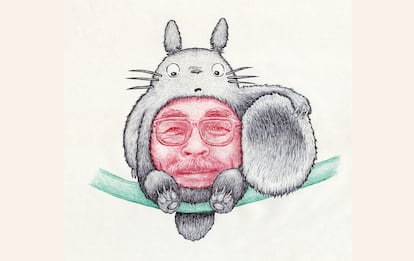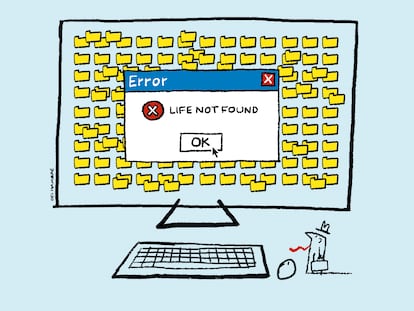The art of living, according to Miyazaki
The octogenarian founder of Studio Ghibli hides luminous keys to our existence in his animated films. We’ve gathered together seven of these lessons

After a long wait that began in 2016, when it became known that Hayao Miyazaki was preparing his farewell film, this fall viewers were finally able to see The Boy and the Heron. Its original title in Japan, How Do You Live?, is that of a 1937 novel that greatly influenced the creator of such crucial animated films as My Neighbor Totoro and the Oscar-winning Spirited Away. But Genzaburō's book bears little relation to this latest Miyazaki film, even though Miyazaki’s boy protagonist finds the novel in his room in the house he moves into after his mother’s death. The classic book, read by all Japanese children in the mid-20th century, tells the story of a boy’s crucial lessons about the true meaning of courage, the injustices of the world and the essence of his own existence. These are also recurring themes in the Studio Ghibli universe that Miyazaki founded. Here are some of the lessons from his filmography that can help us in the difficult art of living.
Magic hides in everyday life
Sometimes it comes about through happenstance or synchronicity, as it happened to the teenage protagonist of Whispers of the Heart. In the film, Shizuku discovers that the same books that she brought home from the library were previously read by someone named Seiji Amasawa, a fact that will have repercussions on Shizuku’s life. How many significant coincidences pass us by when we’re not being attentive to our surroundings?
Your power lies outside your comfort zone
Ghibli characters find their true dimension when they leave their familiar world and adventure out into the unknown. In the case of The Boy and the Heron, the protagonist’s recklessness in deciding to enter his family’s cursed building allows him to get past the pain caused by his mother’s death, and begin to heal the relationship with his stepmother.
We need nature for emotional balance
At the heart of eco-anxiety is the separation between human beings and the natural home that gives us life. Many people look for healing by returning to the countryside, as does the father of Satsuki, one of the children in My Neighbor Totoro, who confesses to her: “Trees and people used to be good friends. I saw this tree, and I decided to buy the house.”
Everybody sets their own limits
Even before reality establishes its own cap on what is possible, we often decide for ourselves what we can or cannot achieve. Given this fact, the breadth of one’s life horizon is conditioned by our own beliefs. There is a moment when Chihiro from Spirited Away asks the dragon Haku about limits, and he responds that the only limits lie in the sky, imagination and ourselves.
It’s all in the details
Miyazaki’s films are characterized by their attention to detail. Viewers follow the path of a cat as it strolls through a residential neighborhood, or the flight of a speck of dust. William Blake put it like this in one of his famous poems: “To see a World in a Grain of Sand / And a Heaven in a Wild Flower / Hold Infinity in the palm of your hand / And Eternity in an hour.” We can only attend to the wonders of life if we open our senses to that which would appear to be insignificant.
We bring our history with us
Spirited Away reminds us: “Nothing that happens is ever forgotten, even if you can’t remember it.” Everything matters and has value. We are the product of everything we have done, seen and felt, even if a large part of it is located in the deep waters of our unconsciousness.
“Reality is for people who lack imagination”
This phrase comes from Miyazaki himself, who has dedicated his life to creating extraordinary worlds that provide respite from the chatter of real life. When we’re finding it hard to deal with bad news or the aggression around us, fantasy inspires us and can even let us come to an understanding of some of the unknown parts of our own personhood. Psychoanalyst Bruno Bettelheim, author of The Uses of Enchantment: The Meaning and Importance of Fairy Tales, says that “each fairy tale is a magic mirror which reflects some aspects of our inner world, and of the steps required by our evolution from immaturity to maturity.”
Watching the movies made by this great storyteller can help us to start our own journey towards alleviating everyday stress, and at the same time nurture our imagination and knowledge of self.
Sign up for our weekly newsletter to get more English-language news coverage from EL PAÍS USA Edition
Tu suscripción se está usando en otro dispositivo
¿Quieres añadir otro usuario a tu suscripción?
Si continúas leyendo en este dispositivo, no se podrá leer en el otro.
FlechaTu suscripción se está usando en otro dispositivo y solo puedes acceder a EL PAÍS desde un dispositivo a la vez.
Si quieres compartir tu cuenta, cambia tu suscripción a la modalidad Premium, así podrás añadir otro usuario. Cada uno accederá con su propia cuenta de email, lo que os permitirá personalizar vuestra experiencia en EL PAÍS.
¿Tienes una suscripción de empresa? Accede aquí para contratar más cuentas.
En el caso de no saber quién está usando tu cuenta, te recomendamos cambiar tu contraseña aquí.
Si decides continuar compartiendo tu cuenta, este mensaje se mostrará en tu dispositivo y en el de la otra persona que está usando tu cuenta de forma indefinida, afectando a tu experiencia de lectura. Puedes consultar aquí los términos y condiciones de la suscripción digital.
More information
Archived In
Últimas noticias
Mexico seeks to shore up its defenses following US incursion in Venezuela
Hope gives way to uncertainty among Venezuelan exiles in the US after Maduro’s capture
Cubans look to Venezuela fearfully after Trump’s incursion: ‘We could be next’
The operation in Venezuela to capture Maduro threatens to widen the cracks in the MAGA movement
Most viewed
- Alain Aspect, Nobel laureate in physics: ‘Einstein was so smart that he would have had to recognize quantum entanglement’
- Gilles Lipovetsky: ‘If you want to live better and fall in love, take Prozac, don’t look to philosophy’
- Alvin Hellerstein, a 92-year-old judge appointed by Bill Clinton, to preside over Maduro’s trial in New York
- Cuba confirms death of 32 of its citizens in the US attack against Venezuela
- Why oil has been at the center of Venezuela-US conflicts for decades










































